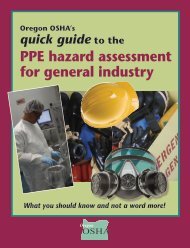Technical Manual - Section 3 (Safety Hazards)
Technical Manual - Section 3 (Safety Hazards)
Technical Manual - Section 3 (Safety Hazards)
You also want an ePaper? Increase the reach of your titles
YUMPU automatically turns print PDFs into web optimized ePapers that Google loves.
needed to prevent HCl from entering sewers and drains.<br />
Health<br />
Because this is a closed process, exposures are expected to be<br />
minimal during normal operating conditions. There is a<br />
potential for exposure to hydrogen gas, hydrochloric acid,<br />
and hydrogen chloride and to dust when solid catalyst is used.<br />
Safe work practices and/or appropriate personal protective<br />
equipment may be needed for exposures to chemicals and<br />
other hazards such as heat and noise, and during process<br />
sampling, inspection, maintenance, and turnaround activities.<br />
POLYMERIZATION<br />
Polymerization in the petroleum industry is the process of<br />
converting light olefin gases including ethylene, propylene,<br />
and butylene into hydrocarbons of higher molecular weight<br />
and higher octane number that can be used as gasoline<br />
blending stocks. Polymerization combines two or more<br />
identical olefin molecules to form a single molecule with the<br />
same elements in the same proportions as the original<br />
molecules. Polymerization may be accomplished thermally<br />
or in the presence of a catalyst at lower temperatures.<br />
The olefin feedstock is pretreated to remove sulfur and other<br />
undesirable compounds. In the catalytic process the<br />
feedstock is either passed over a solid phosphoric acid<br />
catalyst or comes in contact with liquid phosphoric acid,<br />
where an exothermic polymeric reaction occurs. This reaction<br />
requires cooling water and the injection of cold feedstock into<br />
the reactor to control<br />
temperatures between 300º and 450º F at pressures from 200<br />
psi to 1,200 psi. The reaction products leaving the reactor are<br />
sent to stabilization and/or fractionator systems to separate<br />
saturated and unreacted gases from the polymer gasoline<br />
product.<br />
NOTE: In the petroleum industry, polymerization is used to<br />
indicate the production of gasoline components, hence the<br />
term "polymer" gasoline. Furthermore, it is not essential that<br />
only one type of monomer be involved. If unlike olefin<br />
molecules are combined, the process is referred to as<br />
"copolymerization." Polymerization in the true sense of the<br />
word is normally prevented, and all attempts are made to<br />
terminate the reaction at the dimer or trimer (three monomers<br />
joined together) stage. However, in the petrochemical section<br />
of a refinery, polymerization, which results in the production<br />
of, for instance, polyethylene, is allowed to proceed until<br />
materials of the required high molecular weight have been<br />
produced.<br />
SAFETY AND HEALTH CONSIDERATIONS<br />
Fire Prevention and Protection<br />
Polymerization is a closed process where the potential for a<br />
fire could occur due to leaks or releases reaching a source of<br />
ignition.<br />
<strong>Safety</strong><br />
The potential for an uncontrolled exothermic reaction exists<br />
should loss of cooling water occur. Severe corrosion leading<br />
to equipment failure will occur should water make contact<br />
with the phosphoric acid, such as during water washing at<br />
shutdowns. Corrosion may also occur in piping manifolds,<br />
Table III:2-16 POLYMERIZATION PROCESS<br />
Feedstocks From Process Typical products................ To<br />
Olefins Cracking Unification High octane naphtha...........Gasoline blending<br />
processes<br />
Petrochem. feedstocks.........Petrochemical<br />
Liquefied petro. gas............Storage<br />
III:2-37
















